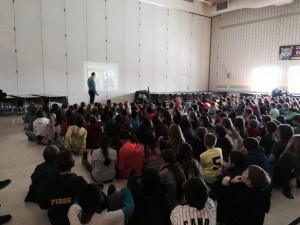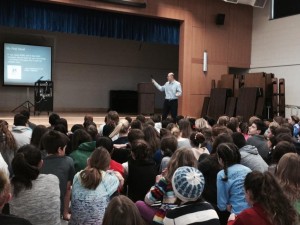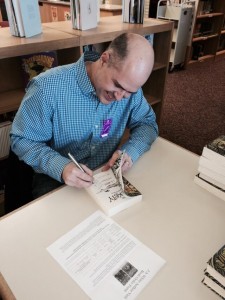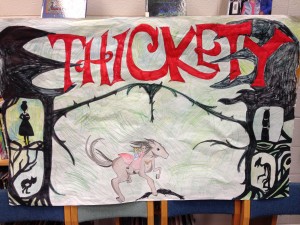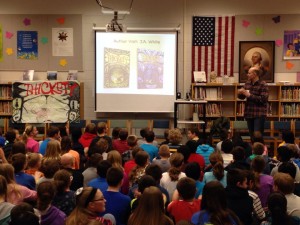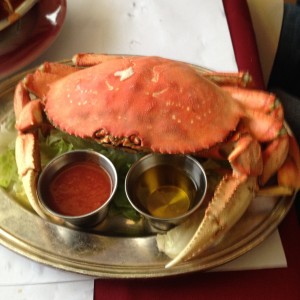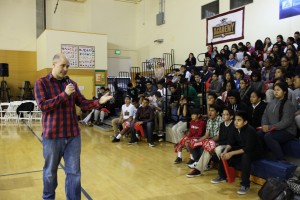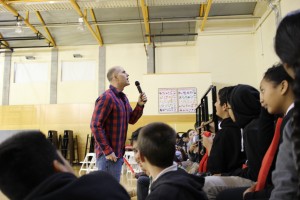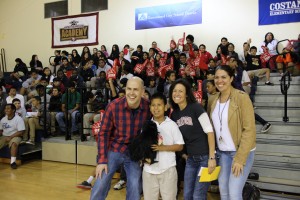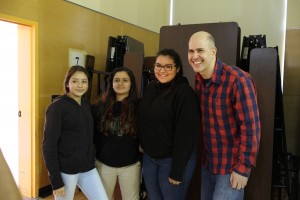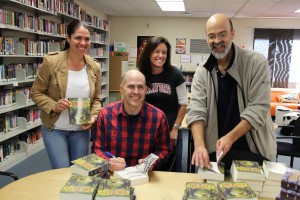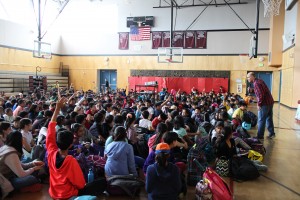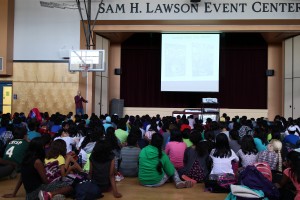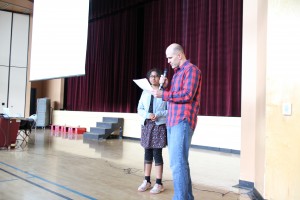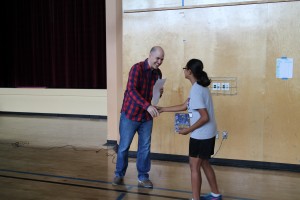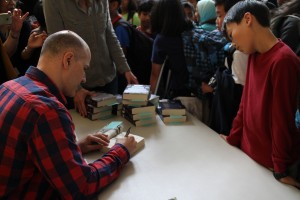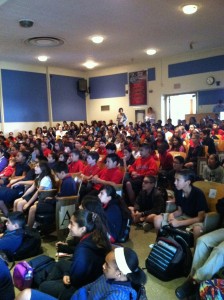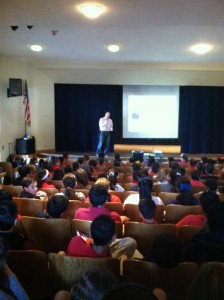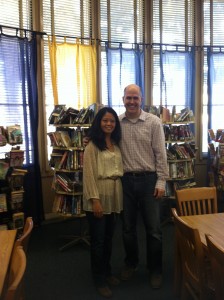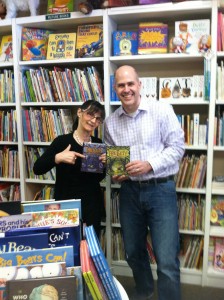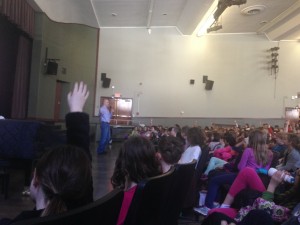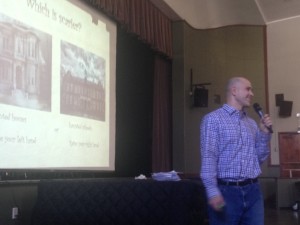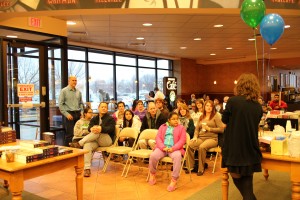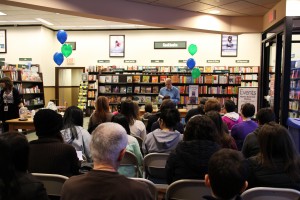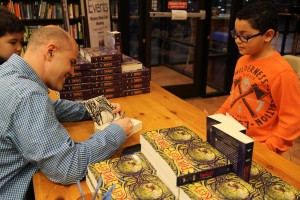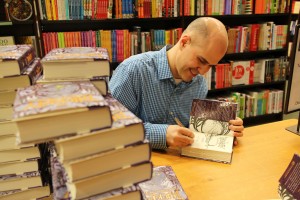The following blog post comes from a really cool roundtable panel that I attended at the NCTE Convention this past November. The idea was to sit teachers down with writer/editor combos (in my case, the wonderful Katherine Tegen). Katherine and I discussed the way we go about revising my books, and hopefully the teachers learned something that they could bring back to their students. I also wrote a packet as a takeaway, which deals with my own personal revision strategies, as well as some of the techniques I’ve used with my students. I figured I might as well throw it up on this blog, since I wrote it and all, and I sincerely hope you’ll find something here that you can bring back to your own classroom!
Writing is a very personal act, and there is no “correct” method. The same goes with revision. First thing I’d like to do is walk you through my own particular writing/revision process, along with some thoughts about how this could be applied to a classroom.
Pre-Writing and the Three Types of Writers
It might seem strange to begin a discussion of revision with pre-writing, but it really does figure into the whole process. It’s important for students to know their “writing identity” because this will determine the type and complexity of revision that will be required. This could also help a teacher differentiate due dates, since some students might need more time to plan while others may need more time to revise.
The first kind of writer is a “planner.” They are outstanding outliners who can see the whole story in their heads beforehand; when they revise, reviewing this outline may help them see story problems/connections that were not addressed in their draft. For this type of writer, the outline becomes a roadmap for what needs to be revised, and most of the major plot developments will remain unchanged. In general, their work will require the least amount of revision, but it might take them the longest to outline.
The second type of writer creates an outline but uses it only as a general guide, allowing the story to change and develop as he/she writes. By the time this type of writer is ready to revise, the outline will be of little use, and indeed the story may have changed a great deal and must be reviewed for inconsistencies. In my experience, this type of writer requires the most time to revise, because the story may have changed drastically during the writing process.
The third type of writer—and I can talk about my own experience here—is a “putterer.” I don’t do an outline at all and mostly “feel” my way through the story. That’s not to say that I don’t do any pre-writing—I have notebooks and notebooks filled with character descriptions, settings, backstories, horrible drawings, maps, and other insane scribblings that I barely ever consult; I make notes because it helps me think. When I start writing, I have only a very general idea of the plot, and I am quite often surprised by what happens. (I feel like this helps me to experience my story as a reader as well as a writer.) I wish I could outline successfully, but I’ve tried it before and it simply doesn’t work for me.
However, because I don’t plan ahead, my writing process is a constant act of revision. I can’t wait until the end of the story to make changes, because without the benefit of an outline I could write myself into an impossible corner. Writing, for me, is a series of starts and stops. I might write an entire chapter and then decide I’m heading in the wrong direction, in which case I’ll throw out that chapter and start over again. (For this reason, instead of just plowing through a first draft and not worrying about revision so much, I am always considering my work critically—too many chapters down the wrong path and I’m in trouble.) When I finish the novel I don’t do a lot of major revisions because I’ve already done that while writing my draft. However, the process of writing the first draft probably takes me the longest of the three types of writers.
(The fourth type of writer is Dean Koontz. He rewrites each page, over and over again, sometimes 25-30 times, until it’s perfect, and then he moves onto the next page. When Mr. Koontz is done with the last page of a novel, he’s 100% finished—no further revision is necessary. I can’t fathom writing this way, but there’s certainly no arguing with his track record! It works for him, and that’s all that matters.)
First Draft Revision Techniques
The Importance of Time
Taking breaks between drafts is an absolutely integral part of the writing process. Before I revise anything I always take a break from my novel for at least a week or two. If I revise right away it’s really hard to distance myself from the story, which is necessary to develop a successful second draft; you want to be able to look at your work as though someone else has written it, as a reader instead of a writer. In a classroom, I would recommend moving onto the first draft of a second story and putting this first story aside for two weeks. By the time students return to these drafts, they’ll have forgotten what was originally in their heads and have to rely only on the words they’ve written (just like a reader), which will allow them to pinpoint issues of clarity. Also, since the amount of work students put into their first drafts will no longer be fresh in their mind, they will usually be more open to constructive feedback.
Outlines
I revise in a very specific order, from the largest chunks (major narrative changes) to the smallest details (language, word choice). This is simply a matter of time efficiency; I don’t want to spend two days perfecting a scene that’s going to get cut anyway. I don’t outline before writing, but I do outline after writing, using my first draft as a guide. Often I use index cards or just a single typewritten page. I find that seeing the plot in this simplified form helps me spot inconsistencies that I might have otherwise missed. (Sometimes I will do mini-summaries while I’m writing as well, if I feel like I might be getting off track.)
I’ve had my sixth grade students write summaries or outlines of their own stories and this has really helped them with the revision process. Another strategy is to have students partner up and outline each other’s stories as part of a writing workshop. This helps student writers see the difference between what they meant to write and what was actually conveyed to the reader.
Checking for Consistent Characterization
Once I’m sure that my major scenes are all going to stay in place, I do what I call character read-throughs. I re-read my draft with the specific purpose of making sure my characters are acting consistently (in action, thought, and dialogue) all the way through the novel. For example, while revising The Thickety: A Path Begins, I did both a Taff read-through and a Grace read-through, reviewing only the scenes they appeared in and thinking about the events through their perspective. Narrowing my revision concerns to individual characters helps me to refine their personalities.
Editing
The last thing I do before submitting a manuscript to my editor is clean up the nitty-gritty details, with a specific focus on trimming as many words as possible. Generally speaking, I’ll cut out 10-15% of my total novel at this point. (This excludes the material I cut while revising my rough draft; throughout the entire drafting process of The Thickety: The Whispering Trees, I wrote 18,000 words that never made it into the final novel.) I never view material cut from a novel as “wasted” work—if I didn’t write it, I never could have figured out the good stuff!
When I feel as though my manuscript is absolutely perfect, I send it to my editor Katherine Tegen—and find out how wrong I was.
Working with an Editor
It takes Katherine a few weeks to read my manuscript and write her notes, which is perfect—by the time I get back to work, I’ve had the needed “space” from the material to help me see things with clear eyes. Katherine’s feedback has two parts: an email with a list of major revisions that might require multiple changes throughout the novel, and the manuscript itself, now with colorful revision bubbles that point out more specific changes. I think that being an editor is an incredibly difficult job, because you need to develop a keen understanding of someone else’s story in order to provide useful feedback—it’s actually very similar to being a teacher! Katherine’s notes always start out with a few positive comments about the manuscript, because she deals with writers all day long and understands our fragile psyches. After this is a bullet-point list of revision ideas. For me, these usually involve areas of the novel that need either clarification or elaboration.
I read these ideas—as well as Katherine’s more specific comments on my manuscript—and then do something completely mindless for about three days. (For my last book, I played a lot of video games with my sons and caught up on Game of Thrones.) I need time for these new ideas to percolate in my brain before I begin to revise. After this, I make a plan for how to approach the larger changes and email Katherine with my ideas, just to make sure we’re on the same page. I leave the shorter edits for now and make the larger ones that involved multiple edits first. Then I work my way through the comment bubbles on the manuscript, making the smaller changes. This is actually my favorite part of the revision process, because it usually involves deconstructing imperfect passages and making them shine, which is incredibly fun and gratifying. I often find myself revising by hand at this point—when I’m struggling to find just the right way to phrase something, good old paper and pencil works better for me than a keyboard.
Once these changes are in place I send the manuscript back to Katherine so she can do another read through and see if I successfully applied her notes to the novel. After this, the revised draft is sent to the copyeditor, who finds a whole slew of new errors to fix (these vary from grammar problems to consistency errors, such as the foolish author changing a minor character’s name or hair color mid-novel). It’s important to note that Katherine does not take the time to address any grammatical errors during her read-throughs; her focus is entirely on any major content changes. I think splitting content revision and copyediting into two separate drafts is a good rule of thumb in the classroom as well.
There might be a few other minor odds and ends to fix before the book is sent to press, but mostly that’s it! Honestly, by the time the final stages of revision roll around I am completely engaged in the next book, so I am really able to view my work dispassionately and objectively. Ideally, students can also be revising and working on their next project at the same time. Keep them writing! 🙂
